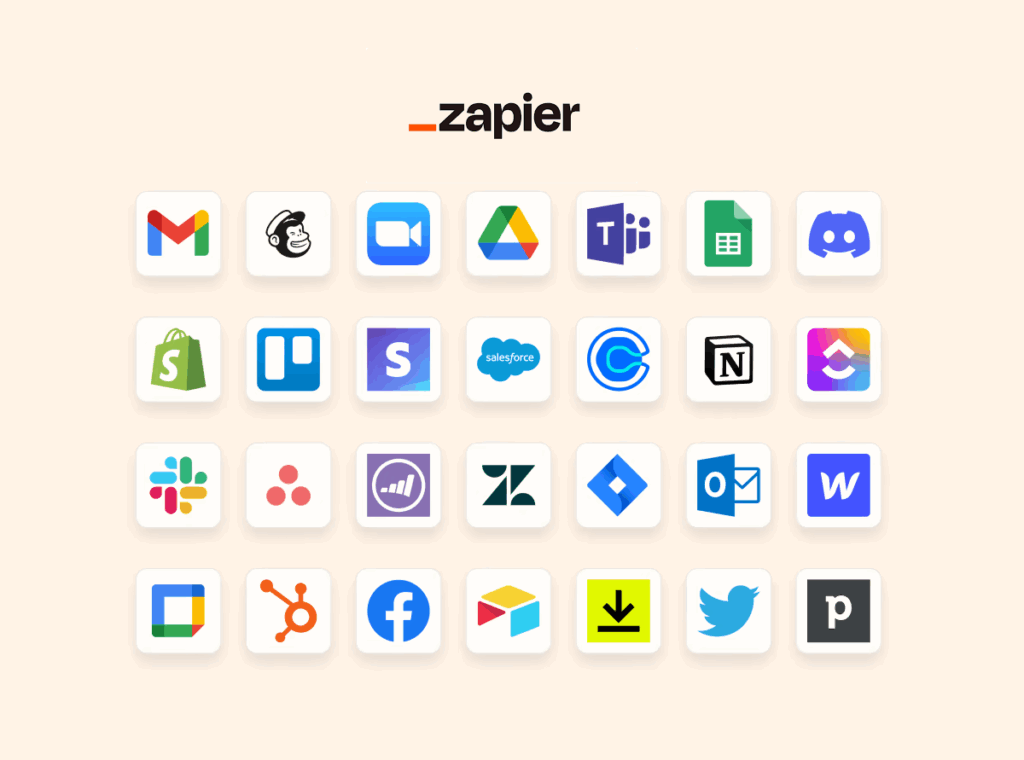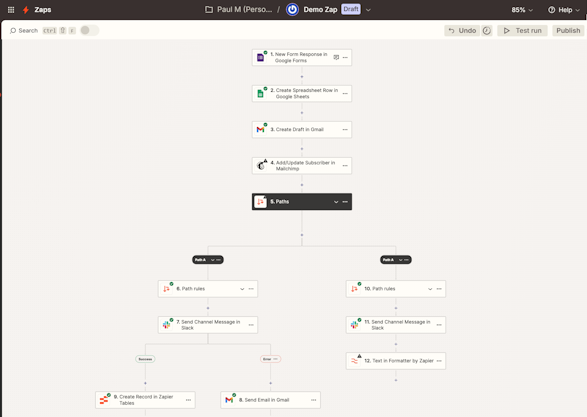Growing a business is bloody hard! Costs are rising, margins are constantly being squeezed. When funds are tight, it’s invariably marketing spend that suffers first — in fact when starting out in business, marketing spend can continuously gets long-fingered in favour of other costs. (That’s the problem, marketing is typically viewed as a cost rather than an investment — we’ll talk about that another time 😉 For today, I want to focus on how you can make that limited marketing spend mushroom into something far more significant with just a little effort and a magic piece of middleware called Zapier.
If you’re running your own small business, you’re probably also acting as your marketing department or have done so at some time in the past. This can involve late nights rubbing shoulders with the shoemaker’s elves while playing catch-up with social media, writing blog posts, sourcing images and creating your own graphics on Canva, cold emailing leads and responding to email queries, looking for a lost enquiry on your email, fighting with MailChimp and the list goes on. You wonder if you’re this relentless workload will ever reward you with some breathing space.

A common recurring problem for start-ups and cash-strapped businesses is that they don’t have the luxury of big picture thinking when it comes to their marketing and operations tech stack. Decisions are made on the fly on a needs basis. Gradually the software subscriptions start to mount up (and the costs!) with no clear strategy as to how these platforms interact. In fact, there’s often overlap in redundant functionality — you’re paying for email automation on Hubspot and Wix and using neither!? It happens.
“If you don’t have the right equipment for the job, you just have to make it yourself.” MacGyver, circa 1985
Zapier is the breathing room your business needs to solve problems when you’re low on resources. It’s like MacGyver’s sticky tape providing functional low-cost integrations while your business grows.

Zapier is a bit of a learning curve but the basics are quite simple and it works with virtually any desktop application you can think of — so there’s no need to fork out big money on fancy marketing automation software too early. It uses Triggers (an event that starts the ‘Zap’) to perform automated Actions (across different software platforms) with optional Filters (i.e. “only act if X is true”) and optional Delays (e.g. create the action after 3-days of inactivity). Multiple actions across multiple platforms can be performed and cascaded from a single trigger. There are limits to how many Zaps you can use at different service levels, but start small, keep what works and ditch what doesn’t.
This is the essence of how you can win time back and save money as a small business owner. Zapier comes in to weave some magic by automating tasks that are a nightly headache for solo entrepreneurs — and the great thing is it’s not just for marketing, it can automate other tasks too and really give you valuable time back. You might even get time for the odd episode of a Netflix box set!
Below are five real world examples of how Zapier can make your life easier as a small business owner.
Scenario: You’ve got a nice website with an enquiry form — this can be using a myriad of different CMS and form platforms e.g. Gravity Forms on WordPress. A form gets filled in — where does that lead go? Hopefully you get an e-mail to your inbox (or better yet a Slack notification) when it lands, if not, fix that first. But what happens when the lead comes in when you’re flat out fulfilling customer orders? Inevitably, some of these get lost in your email — potential revenue down the drain and a bad first experience for the customer, who may never come back.
Solution: Zapier acts as the middle man between the web form on your website and wherever you store leads (this can be a CRM or even just a Google Sheet) — this gives you a centralised place for all your leads without any ongoing manual work. It’s simple, Zapier sends the form details to a spreadsheet which you can review at any time. You can also configure Zapier to send you specific notifications (e.g. if web form message contains “urgent”, “help” etc.). With Zapier, you have a personal assistant in lead management.
Scenario: You may have invested valuable early funds in a CRM with limited opportunity to learn how to use it fully. Over time it has become nothing more than a junk drawer — you know, that drawer in your home where random stuff goes but never, ever get used again(used batteries, blue-tack, key-rings etc. It’s a treasure trove for MacGyver!). If this is your CRM, then Zapier is your resuscitation device. The bit that’s missing here is CRM administration. An employee with responsibility for this work is invaluable but unfortunately, they are a luxury for small businesses.
Solution: Zapier can be configured to act as your CRM administrator, quietly tidying up your junk drawer without you even noticing. For example, a Calendly booking through your website or social media account can automatically create or sync to a customer’s record on your CRM. In this improved situation, your data is clean and you have an audit trail of interactions with your customer in one place, which you can revisit at any stage.
Scenario: You are using website or social media forms to capture leads (e.g. discount codes, special offers) but the lead quality is very much hit and miss. The preferred next step is to begin a sales conversation but if this is premature, the best foot forward is to nurture them to understand more about your business through an email marketing sequence. This may involve manually adding details from your webform to your email platform (e.g. MailChimp) which is a repetitive task that can produce errors, especially when you’re trying to get it done in a rush amongst a million other things that need your attention.
Solution: Zapier does the heavy lifting by syncing data between your web forms and your email marketing tool of choice (MailerLite is an alternative to MailChimp). Zapier can also be configured to add the user to a specific audience segment based on what they filled out in your form and an automated campaign can be triggered. In this revised scenario, web form enquiries are routed through to a centralised database (CRM and/or mail platform) and are drip-fed information on your business over days/weeks without you having to do any of it.

Scenario: Your e-Commerce website is configured to take orders but it’s peak season and you’re inundated with orders to process. This seasonal bottleneck is commonplace for small businesses and it’s typically where the paperwork suffers and the customer can be left unsure of where they stand.
Solution: Zapier can be beavering away in the background making sure that nothing is dropped — once an order is processed a ‘Thank You’ email can be triggered by Zapier through MailerLite (or alternative email marketing platform), your customer’s CRM record is updated with details of their order and the order processing and sales departments are notified via Slack in case they are fielding calls from the customer wondering where their order is. Once the order is dispatched (e.g. Google Sheet update) another notification can be sent to sales team so they can ring the customer and let them know when to expect their order, with an Order Delivery email confirmation also triggered by Zapier.
Scenario: When orders get processed (e.g. on a Shopify shopping cart) or over the phone, you want to be sure that your i’s are dotted and t’s crossed. Losing a lead is bad, losing a confirmed order is so much worse. You may not have a full-time accountant (yet!) but you can’t wait a few days for them to return to the office before doing the paperwork around orders that are happening every day.
Solution: User Zapier to update your inventory on Google Sheets, create a trigger to issue an invoice via QuickBooks or Xero accounting platforms and update the customer record in your CRM to include details of their order. This centralisation of data and interactivity between software platforms acts like a safety net ensuring nothing gets dropped but it also reduces the manual effort for your accountant — the money is in, the invoice is sent and they haven’t even turned up for work yet. This additional efficiency is a big win for small businesses and gives you a solid foundation for scaling with confidence.
With Zapier, the possibilities are endless. A little bit of time spent thinking about how your business currently operates, where the bottlenecks are and how things might run better can lay the foundations for scalable operations that offer greater efficiencies without incurring massive costs. It’s important not to get lost with automation — focus on automating what already works in your business, don’t try to introduce automation into a problematic area of service delivery and don’t try to over-engineer your automation. Take small steps, each improvement is a valuable time saving which you can bank towards future business growth.
Zapier’s most basic subscription level is free — so try it out — once you get stuck into it, it’s a fun tool to use. Once you’re comfortable with the basics and understanding the conditional logic in creating Zaps, then you can take it to the next level by configuring additional filters and paths as well as including time delays before actions take place.
To provide the best experiences, we use cookies to store and/or access device information. Consenting to cookies will allow us to process data such as browsing behaviour or unique IDs on this site. Not consenting or withdrawing consent, may adversely affect certain features and functions.